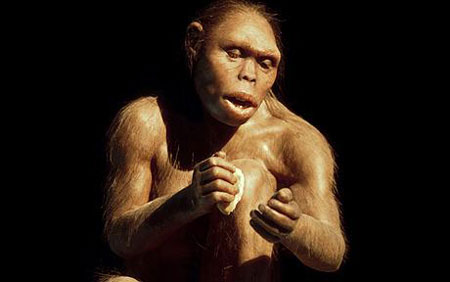Rare discovery of prehistoric human bones
A prehistoric human skeleton that scientists have discovered in South Africa can help us fill in the missing information in the gap in the evolutionary story of mankind.

Illustration of Homo habilis strain.Scientists believe that Homo habilis is the earliest modern human race.Photo: SPL.
Although archaeologists have unearthed several thousand fossils of human ancestors across the globe, we still cannot complete the story of the process by which primates evolved to become modern people. . The main reason is that we have not found the link between humans and primates. The absence of this important link makes it difficult for scientists to establish precise timelines in human history. That is why those who oppose evolution theory argue that primates are not the ancestors of humans.
But, according to the Telegraph, recently scientists from the University of Witwatersrand, South Africa, found a nearly complete skeleton in the Sterkfontein region in the country. Professor Lee Berger, one of the three discoveries of the skeleton, said he and his colleagues saw it while unearthing the caves in the Sterkfontein region - near Johannesburg. So far, the discovery of a nearly complete prehistoric skeleton is an extremely rare event.
The analytical results show that the skeleton represents a human race that we never knew. Experts say the creature of the skeleton once existed during the period when primates evolved into Homo habilis , the first modern human race that appeared about 2.5 million years ago. The discovery was so important that South African President Jacob Zuma himself went to the University of Witwatersrand to see the skeleton. South African officials will also host a major media campaign to promote the event.
Today most of the scientific community recognizes Africa as the birthplace of humanity. Here simple primates have evolved into a common ancestor of humans, gorillas, chimpanzees. Experts believe that about 3.9 million years ago a group of gibbon-like people appeared on the south and east of Africa. They called them Australopithicus afarenus . In the process of evolution Australopithicus afarenus gradually lost the characteristics of primates because they began to stand upright and their brain volume increased.
Then about 2.5 million years ago Homo habilis - the first in the modern group, began to appear. Scientists found very few fossils of this human race, but there is a theory that they are descendants of the Australopithicus afarenus strain. According to the Telegraph, it is very likely that the skeleton just found existed during the period when Australopithicus afarenus evolved into Homo habilis.
If the hypothesis is confirmed to be true, it will have tremendous significance for science, because it will help us fill in the gaps in the evolutionary history of modern people.
- Detecting fossils of human bones living on trees
- Vietnam first discovered prehistoric bones in a volcanic cave
- New discovery: Human ancestors are sharks
- The oldest fossil bone human excavated outside Africa
- 10 interesting things about the human skeleton
- Interesting facts about bones are not well known
- The first massacre in human history
- The relics in the volcanic cave have bones of prehistoric people in Dak Nong
- Associate Professor Nguyen Lan Cuong first approached the prehistoric skull
- Human jaws evolved from ancient fish
- Discover rare and precious southern mammoth bones
- New discovery of Au fossils. Sediba
 Discovered an ancient centipede fossil 99 million years old
Discovered an ancient centipede fossil 99 million years old Discovered bat-like dinosaurs in China
Discovered bat-like dinosaurs in China Discovered a 200-year-old bronze cannon of the coast
Discovered a 200-year-old bronze cannon of the coast Discover 305 million-year-old spider fossils
Discover 305 million-year-old spider fossils